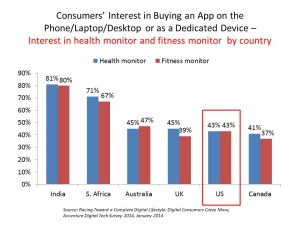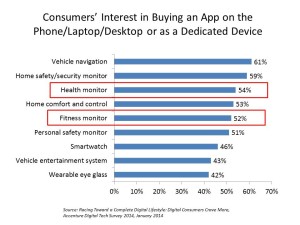Wearable technology is the new fashion accessory, Accenture observes in its 2014 survey report, Racing Toward a Complete Digital Lifestyle: Digital Consumers Crave More.
In parallel with the supply-side growth of wearable technology that is seen this week at the 2014 Consumer Electronics Show, Accenture brings a sanguine story to the supply side of the equation, finding consumers “craving more” than one function from a digital device. Over one-half of consumers surveyed in six countries favored vehicle navigation, home safety/security monitors, health monitor, home comfort and control, fitness monitors, and personal safety monitors. Nearly one half (46%) liked smartwatches, and 42% were interested in wearable eye glasses (a la Google Glass).
Accenture surveyed 6,000 consumers in six countries for the study: Australia, Canada, India, South Africa, United Kingdom and the United States.
 Through the health lens, 54% of global consumers would be interested in buying a health monitor tech, and 52%, a fitness monitor technology.
Through the health lens, 54% of global consumers would be interested in buying a health monitor tech, and 52%, a fitness monitor technology.
Accenture’s survey differentiated between health and fitness monitors as follows, according to David Sovie, managing director with the firm’s communications practice: a health monitor would measure heart rates and other vital signs, whereas a fitness monitor would measure exercise and track progress such as distance and speed.
Based on these definitions, health citizens in India and South Africa are most keen to access a health or fitness technologies, shown in the second chart which organizes the health/fitness monitoring question by each of the six countries polled.
It’s striking to note that in the U.S., 43% of consumers were interested in purchasing a health or fitness technology as highlighted in the second chart. While fitness apps have historically been more popular than more medical-oriented tools, this survey shows that equal proportions of people like the idea of each – health/wellness vs. health “care” (think: pedometer/step tracking vs. heart function).
Health Populi’s Hot Points: Accenture concludes the report with implications for consumer electronics companies, noting that “consumers are creating their own unique constellation of devices and services that fir their personal lifestyles and activities in which they want to engage….Device makers and service producers must understand explicitly how they fit into the digital constellations being created by discrete customer segments.” Furthermore, developers should be mindful of how consumers use these technologies in the context of others.
This last point is key in the case of health. Each of us project-manages our health in a variety of ways: some people have a medical home and relate very closely to a doctor; others of us DIY our health individually or socially, with peers; most people make a combination of both health system and DIY aspects, where we “live, work, play and pray.”
A majority of people in the U.S. self-track health…but
- 49% of trackers say they keep track of progress “in their heads,
- 34% track the data on paper (e.g., a notebook or journal),
- 21% use some form of technology to track their health data,
according to the Pew Research Project’s self-tracking data from 2013. Thus, the chasm between the Pew statistic and 43% is wide. That’s some kind of hockey-stick demand for wearable digital health/fitness devices for 2014.
Of course, this will happen over time. While the CES press releases and their uptake by media reporting even before the meeting celebrate a “40% growth” in digital health at the Las Vegas Convention Center year on year (to about 300 health companies this year), consumer adoption of digital health devices will happen over a matter of years….not months.
Are we in an era of irrational exuberance with respect to digital health? Just how many consumers really want to self-track, wear a digital wristband of courage, measure their sleep, heart function, or skin temperature…and pay for the device or app to do so? This response is what we economists define as true “demand” — that is, willingness to pay for the products. What complicates the answer(s) may also be the fact that, in health care, financing such devices could be cost-shared or prescribed by the health care system and reimbursed by health insurers or providers at-risk for population health.
We will have a better sense of the answer to that question a year from now.





 Thank you, Jared Johnson, for including me on the list of the
Thank you, Jared Johnson, for including me on the list of the  I am so grateful to Tom Lawry for asking me to pen the foreword for his book, Health Care Nation,
I am so grateful to Tom Lawry for asking me to pen the foreword for his book, Health Care Nation,  Thanks to Feedspot for naming this blog, Health Populi, as a
Thanks to Feedspot for naming this blog, Health Populi, as a